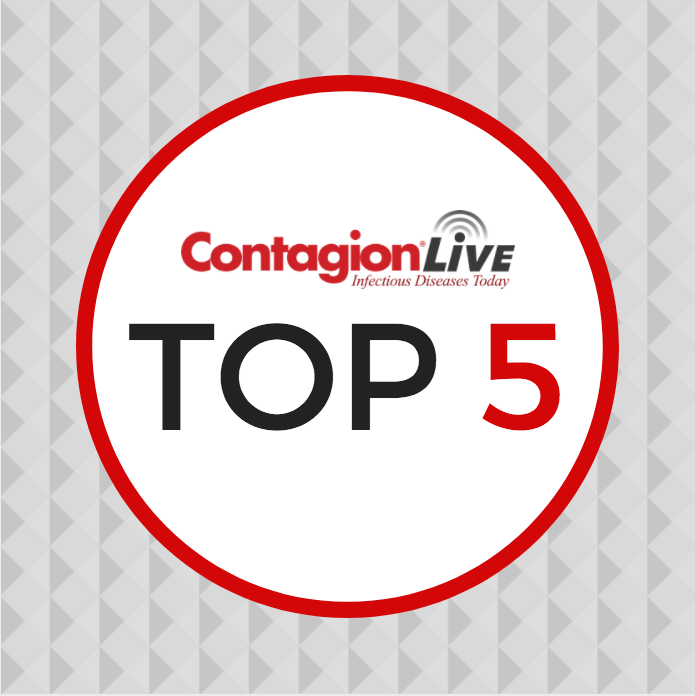Top Infectious Disease News of the Week—October 1, 2018
Stay up-to-date on the latest infectious disease news by checking out our top 5 articles of the week.

#5: Severe Influenza May Be a Risk Factor for Aspergillosis: Coverage from ID Week 2018
Although rare, invasive aspergillosis may be a risk factor for patients with severe influenza, according to the results of a recent study presented in a Poster Abstract Session at ID Week 2018, held this year in San Francisco, California.
In the study, Mitsuru Toda, MS, PhD, from the US Centers for Disease Control and Prevention (CDC) Mycotic Diseases Branch, along with her team, shared documented evidence that more than one-third of patients with invasive aspergillosis lacked documented immunosuppressive conditions.
Past research has suggested that Aspergillus infections can result in invasive disease in the setting of severe influenza, including in patients without classic risk factors. Pathogenesis of the infection in this setting could include viral disruption of the respiratory epithelium as well as impaired local immunity.
Read more about severe influenza as a potential risk factor for aspergillosis.
#4: Progress in Fighting Ebola, Yet Resistance to Treatment in the DRC Remains: Coverage from ID Week 2018
The Democratic Republic of the Congo has come a long way since 1976 when the first Ebola outbreak was declared. In October of 2018, the country is dealing with the tenth Ebola outbreak that has, this time, occurred in a region ripe with political turmoil.
In a presentation at ID Week 2018, Mary Choi, MD, MPH, Viral Special Pathogens Branch, US Centers for Disease Control and Prevention (CDC) discussed the current outbreak as well as the outbreaks that devastated the nation in the past.
An earlier outbreak in 2018 which was active from May to July, struck in the Èquateur Province located in the Western part of the DRC, an area with a population of 2.5 million. The final case count in the outbreak was 54 confirmed or probable cases.
The current outbreak, which was first reported on July 28, 2018, already has a higher reported number of cases than the previous outbreak did, with 150 cases reported as of September 28, 2018.
Read more about Ebola in the DRC.
#3: First Case of Rat Hepatitis E Virus Identified in Human
Investigators from the University of Hong Kong’s Department of Microbiology have identified the first case of rat hepatitis E virus in a human.
A 56-year-old man underwent a liver transplant at a hospital in Hong Kong in May 2017 after suffering from chronic hepatitis B, according to the investigators. In September 2017, hospital physicians observed inflammation of the liver, but the absence of symptoms associated with a transplant rejection.
Physicians ruled out any infection from the transplant and donors and the patient was subsequently tested for liver infections hepatitis A and hepatitis E, both of which were negative.
After performing genetic sequencing of a specimen from the patient, investigators noticed similarities with the rat strain of hepatitis E; therefore, they gave the man antiviral treatment for his infection. The man has since been cured.
Read more about the first case of rat hepatitis E in a human.
#2: HIV-Positive Patients at Higher Risk of Late Mortality Following Cryptococcal Infection: Coverage from ID Week 2018
Cryptococcosis continues to be one of the most common opportunistic infections and causes of mortality in patients living with HIV. Thanks to antiretroviral therapy, early overall mortality following cryptococcosis in people living with HIV has decreased considerably; however, not much is known about late mortality in patients living with the virus.
New research being presented in a Poster Abstract Session at ID Week 2018, suggests that patients living with HIV have high mortality following cryptococcal infection which persists beyond initial hospitalization. As such, the investigators stress the need to identify patients who are at increased risk of mortality in order to improve patient outcomes.
For their retrospective cohort study, the investigators analyzed demographics, clinical features, diagnostics, and outcomes of patients with HIV and cryptococcosis occurring from January 2002 to July 2017 at Barnes Jewish Hospital in St. Louis, Missouri. Death dates were collected from the hospital system’s Medical Informatics database as well as the Social Security Death Index.
Read more about mortality in HIV-positive patients with cryptococcosis.
#1: Infection Preventionists and Antimicrobial Stewardship Programs, A Marriage in Progress
Antimicrobial resistance is a rapidly growing problem that involves everyone. Efforts to combat this problem span across health care, from pharmaceuticals to biomedical organizations, veterinary medicine, agriculture, and more. Health care-associated infections as a result of resistant organisms result in significant morbidity and mortality for the patients, not to mention the potential transmission that can occur. The cost of health care for patients with resistant infections is higher than care for those without such infections.
The practice of antimicrobial stewardship is one tool to combat antimicrobial resistance and the spread of these multidrug-resistant infections. Antimicrobial stewardship programs help reduce antimicrobial resistance by reducing unnecessary use and better prescribing habits.
These initiatives are a critical aspect of medical care as each year in the United States, 2 million people will battle antibiotic-resistant infections and 23,000 of these individuals will die.
Read more about infection preventionists and ASPs.
